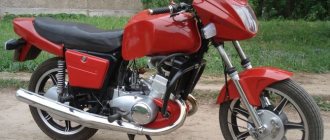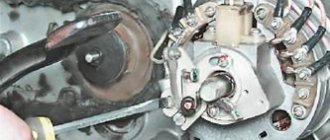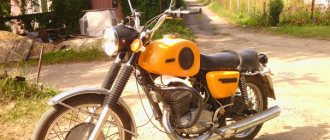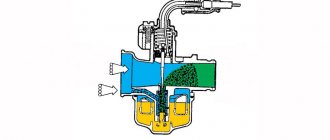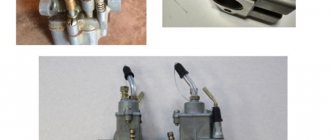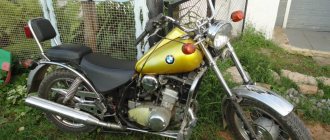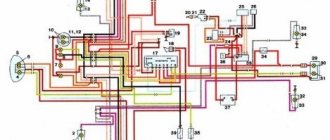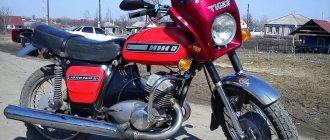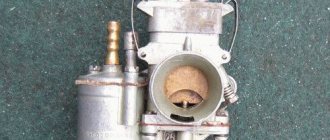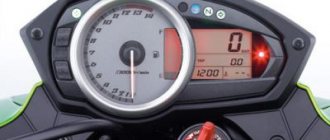Design of Planet Sport from Izhmoto
The technical characteristics of the PS were amazing.
This was the first serial steel horse in the USSR with a separate engine lubrication system. Moreover, the latter was the own development of the designers of the Izhevsk Motor Plant. The bikes released from the assembly line in 1974 could boast of this feature. A characteristic sign of the presence of such know-how in the IZH Planet Sport motorcycle is the presence of the letter “M” in its number. The PS engine from Izhmoto had a slightly increased displacement compared to previous models from Izhevsk. It was 349 cm³. It is noteworthy that the iron horse received a Japanese Mikuni carburetor from the factory. This allowed the bike to produce the coveted 32 hp. and 6,700 rpm.
With a dry motorcycle weight of 135 kg, it could boast enviable technical characteristics (237 horses per ton of weight). This was almost double the figure for the Jawa 350 “634”.
Izh PS reached 100 km/h in 11 seconds. The engine of this horse was attached to the frame using rubber cushions. For the 1970s, this was a real technical innovation. In addition, the bike was actively equipped with Japanese electrical equipment and even optics. The same models of the IZH PS motorcycle that were equipped with a domestic carburetor (K 62M) could develop slightly less power of 28 horses. Since 1978, Soviet electrical equipment and a domestic speedometer have been installed on this iron horse. These bikes had larger spoke diameters.
Technical characteristics of IZH Planet Sport
During 1975-1983.
the bike often went through design changes. It was modernized and improved. Therefore, all Izh PS motorcycles do not have the same technical characteristics. Yet some of them did not change. The length of the bike is 207 cm. Its width reaches 79-81 cm. At the same time, the height of the bike is 115 cm.
The maximum recommended speed of the Izh PS motorcycle is 140 km/h. This bike consumes 3.5 liters of fuel per 100 km (at a speed of 60 km/h). In the city, consumption increases slightly and reaches 7 liters.
The braking distance of the Izh Planet Sport motorcycle is still significant and amounts to 16 meters at a speed of 60 km/h. At a speed of 30 km/h, the motorcycle will need only 7 meters to come to a complete stop.
The technical characteristics of the PS Izhmoto engine are also impressive. The engine of this two-wheeled sportbike has a two-stroke type of operation. Its three-channel blowing has proven itself well.
One cylinder is more than enough for this bike to develop considerable power. The diameter of the latter is 76 mm. The Izh Planet Sport motorcycle has a power unit that has a fairly high compression ratio (10.5). The cooling system actively uses oncoming air flows. The filter for purifying air before it is supplied to the mixture is of the dry type. It was supplemented with a paper element.
Alex0133 › Blog › Izh Planet Sports 1975 onwards in the original.
As Wikipedia says to us .: Izh Planet Sports is a middle-class road bike designed for tourists and sports trips on roads with different surfaces, alone or with a passenger. It was produced by the Izhevsk Motor Plant from 1973 to 1984. In 1973, not many of these motorcycles were produced; a trial batch of about 500 motorcycles, among other components, had a service book. Therefore, the official year of launch is 1974.
But now we will talk about Planet Sports 1975, preserved in its original form. He stood in our city in one of the garage cooperatives. The owner was selling the garage, and the motorcycle was in the way. So he became mine. Of course I had to bring it in a decent form, because during standing, he lost his former gloss and attractiveness. I want to note that, surprisingly, all the details on the motorcycle remained native: everything corresponds to the factory equipment to the smallest detail, right down to the light bulbs.
Even the air filter was relatively clean.
Also, its own rubber has not lost its former shape and looks hearty)
You can understand why such a condition of the motorcycle, because the mileage at the time when I got it was only 5620 km. Now it has slightly increased, because how cool it can be to ride a dog around the city, attracting the attention of passers-by.
The IZH PS motorcycle was amazing
First of all, the gear ratios of this bike’s gearbox are amazing. In addition, the motorcycle received improved shock absorption as a gift from the designers. The electrical equipment at PS Izhmoto is surprising for such an old Planet model. The bike has an on-board network with a voltage of 12 volts. The three-phase alternating current generator is capable of delivering 14 volts and a power of 100 watts.
Note that the very first iron horses of this series were equipped with foreign batteries.
The very first Izh PSs were supplied with Italian Magnetti-Marelli spark plugs. Often these were “NGK” spark plugs, which are recommended for use at high speeds (from 100 km/h). At the same time, the gasket was removed from the cylinder head.
The fuel tank of the Izh Planet Sport motorcycle had a volume of 14 liters. AI-93 gasoline was considered the most suitable for refueling this bike. The oil tank of the iron horse held 1.5 liters.
Technical properties of Izh Planet
To have a complete understanding of the abilities of the first representative of Izhevsk bikes, let’s turn to the technical features of the Planetka.
| External characteristics (length/width/height) meters | 2,115/0,78/1,025 |
| Base from wheel to wheel, meter | 1,4 |
| Proposed ground clearance, centimeter | 13,5 |
| Allowable high speed limit | 100 km per hour |
| Dry weight | 158 kilograms |
| Fuel tank volume, liter | 18 |
| Gasoline consumption at 60 km. at one o'clock | Up to 3.7 l. per kilometer hundred |
| Motor properties of "Izh Planet" | The type is two-stroke for one cylinder with a diameter of 7.2 cm and a capacity of 346 cm3; piston with a stroke of 8.5 cm, compression of 6.7 |
| Power limit | from 4200 to 4600 rpm, liter 13 |
| Cooling type | Air |
| Lubrication mechanism | Mixed with gasoline |
| Carburetor brand | K-28I |
| Allowable voltage, volts | 6 |
| Checkpoint (Checkpoint - a point designed to control passage (visit) and access to the territory of any facility) | Four steps and two moves |
| Fork | Telescope with hydraulic springs |
| Rear suspension | Pendulum with hydraulic springs |
| Brakes | Pads |
| Wheels | Obediently removed, spoked |
| Tires in inches | 3.25x19 |
| Gas tank | 14 l., fuel grade - AI-93 |
| Oil tank | 1.5 liters; aviation oil brand - MS-20 |
In various videos you can clearly see what tricks and inventions the owners of their own motorized vehicles go to in order to create their own two-wheeled stallion better, more attractive and more noticeable.
Factory upgrades to the Izh Planet model were numerous. And of course, no matter what model line, it simply must have in its ranks a unit of the “sport” class. Izh Sport is considered one of the most beautiful and high-speed options.
Sports class models have always been considered elite in the motorcycle industry. They received special attention because they represented the capabilities of Russian production and received the best equipment. The sports motorcycle car was distinguished by grace and noticeable thinness, which is visible in the photo of Izh Planet Sport and is very reminiscent of the Japanese type produced in the middle of the twentieth century.
The front wing, which has an original mount, a fascinating hub and a different version of the rear wing, draw before your eyes an image acquired by a mix of “Suzuki”, “Yamaha” and “Kawasaki Samurai”. The most distinctive touch was the color of the bike: from yellowish to orange with black details and nickel plating of individual parts, causing quiet ecstasy. Motorcycle enthusiasts, quickly appreciating all the beauties of the new model, affectionately called it “dog”, from the abbreviation “Planet Sport” . To this day, being the owner of this motor vehicle is considered an honor and arouses universal respect among connoisseurs and bikers.
Motorcycles "Java"
Another legendary Jawa motorcycle dates back to 1929. This brand of road transport belonged to a Czechoslovak company and was the dream of many Soviet motorcycle enthusiasts. Motorcycles were used not only for everyday travel, but also participated in various racing competitions. In the 21st century, the production of Java has not stopped; some models are still in demand.
Jawa 350 Classic
The motorcycle is based on a 2-cylinder, 2-stroke system with a 4-speed gearbox. There is no connection between gasoline and oil thanks to a separate lubrication system. The motorcycle frame is strong, which allows you to load motor vehicles up to 200 kg. It is possible to attach a car seat.
If we compare the Jawa 350 Classic 638 model with others, more expensive and equipped, it wins in several respects: maintenance is simple and inexpensive, fuel consumption is low, spare parts are available for sale at a low price.
Technical characteristics of "Java" 350 classic:
- dimensions – 2110×750×1070;
- engine capacity - 343.5 cubic meters. cm;
- power – 23.1 l. With.;
- maximum speed – 125 km/h;
- gasoline consumption per 100 km – 4 liters;
- manual gearbox.
Jawa 350 Classic Sport
“Classic Sport” is an improved version of Jаwa 350 Classic. It was presented in 2021 at the Moscow Motopark exhibition. You can distinguish the model from other Java motorcycles by the “outdated” design of London in the 60s, when street motorcycle racers converted inconvenient and bulky motorcycles for themselves, removing everything unnecessary. The two-wheeled vehicle turned out to be light and maneuverable, with streamlined elements.
Jawa 350 Classic Sport is designed for solo travel and is equipped with one comfortable seat. The low steering wheel allows you to comfortably take the position of the rider, fully concentrating on the ride. The “rarity” of the motorcycle is reminiscent of its classic elements: a wide chrome exhaust pipe, a round headlight and a traditional red body color.
The motorcycle has a lot of advantages that make for a comfortable and maneuverable ride: a 343 cc engine, a separate lubrication system, a reliable disc-type brake system, a laconic dashboard and an automatic starter.
Specifications:
- engine capacity – 343.5 cubic meters;
- number of cylinders – 2;
- number of cycles – 2;
- power – 23 l. With.;
- maximum acceleration speed – 125 km/h;
- gasoline consumption per 100 km – 4 liters;
- air cooling system.
Jawa 350 Lux
The presented model is a classic version of a street class road motorcycle. It combines elements of older models, but also has individual modern features. The front of the motorcycle has a classic single headlight, and the electronic instrument panel is simple and understandable even for novice motorcyclists.
The basis of the two-wheeled design is a strong steel alloy frame. Its rigidity improves maneuverability on uneven roads, makes the vehicle maneuverable and increases load capacity. The holistic appearance of the Java 350 Lux clearly resembles a “classic”.
Specifications:
- dimensions – 2110×750×1070 mm;
- engine capacity – 343 cubic meters. cm;
- number of cycles – 2;
- number of cylinders – 2;
- power – 23.1 l. With.;
- maximum speed – 125 km/h;
- Fuel consumption per 100 km is 4 liters.
Jawa 660 Sportard
The most powerful Java model in terms of technical equipment is the 660 Sportard. The engine capacity of 600 cubic meters affects the ability to reach speeds of up to 250 km/h. The motorcycle covers distances along the highway easily and maneuverably. For beginner motorbikers, this is an excellent tool - flexible and playful. And externally, the 660 Sportard looks more aggressive and modern than the classic versions.
The technical characteristics have their own characteristics: the power plant is “single-barrel”, equipped with an electronic injection system - EFI
The frame frame has a high degree of rigidity, and this is an important condition for off-road driving - the motorcycle does not twitch and is easy to control. The upgraded suspension of the bike allows you to take turns at the same speed without pressing the brake pedal
The technical specifications are as follows:
- dimensions – 2100×760×1250 mm;
- cylinders – 1;
- number of measures – 4;
- engine capacity – 651.9 cubic meters. cm;
- power – 48 l. With.;
- gas tank volume – 17 liters;
- Manual transmission – 5-speed.
Five random motorcycles:
Triumph Street Triple 675 10th Gray Anniversary SE 2017
RUB 127,000*
Yamaha TW 200 2016
Maico Supermoto 380 2001
Maico GS 350 / 360 1991
RUB 246,000*
Kawasaki EN 500C Vulcan Classic 1996
Three improvements to the Java 634 for motorcycle tourists
Three proposals On the YAVA-634 motorcycle, for more convenient maintenance, I introduced a number of improvements that may be of interest to motorcycle tourists. Here are three of them: 1. To prevent dirt from clogging the gap between the wheel and the shield when traveling on dirt roads, I raised the shield by installing an extension (photo 1) made of sheet steel. 1. This is what the shield bracket extension looks like. 2. I secured the panel under the saddle (photo 2). on which I placed a ground switch 2 (toggle switch), a block 3 with a fuse, two sockets 4 for connecting the battery, a socket 5 for connecting a lamp mounted in the base of the saddle (it illuminates the seat space), and two sockets 6 from which you can take power supply for a portable lamp, receiver, vulcanizer, etc. 2. Underseat space: 1 - panel: 2 - toggle switch; 3 — block with fuse; 4 — sockets for connecting the battery; 5 - socket for connecting a lamp embedded in the base of the saddle...
Elimination of loose brake pedal on an IZh motorcycle with a sidecar
Reliable fastening On IZh motorcycles with a sidecar equipped with a brake, the pedal soon becomes loose. In this case, the order of operation of the brakes of the motorcycle and the trailer is disrupted, which is why the crew skids to the side when braking, especially sharply. In addition, the adjustment of the brake light switch changes. To eliminate this drawback, I turned out axle 9 (see Fig. “b”) and attached the brake pedal to it, drilling a hole in the support plate 2 of the frame to 12 mm. Since then this unit has been working properly. Brake pedal mounting unit: a - factory version; b - revised version; 1 — brake pedal; 2 — frame support plate; 3 — M10 bolt; 4 - bushing; 5 - spring washer; 6 — nut M10; 7 — washer; 8 — M12 nut; 9 - axis. This modification will not hurt those who travel without a stroller. Gorky city GRACHEV 1987N09P33
Two forces more powerful. Boosting the IZH-36/IZH-Planet engine
Increasing engine power is a question of interest to many motorcyclists. And this is understandable: the dynamic and other parameters of a motorcycle are directly dependent on the power of its engine. We have already told you (“Behind the Wheel”, 1967, No. 1) how to increase the power of the IZH Planet engine to 18 hp. With.
Rice. 1. Changing the diameter of the carburetor diffuser Some readers, who are not able to complete the entire amount of work recommended in the article, ask about simpler methods that allow them to obtain at least a small (two to three times the power) increase in power. In the published article by engineers V. Abrahamyan, A Maksimov and B. Lezhnev owners of IZH 36 and IZH Planet motorcycles are given recommendations on how, by making minor changes to some components and parts of the engine, increase power to 15 hp. The design changes proposed by the authors do not increase fuel consumption and have virtually no effect on the durability and reliability of the motorcycle. The main means of increasing engine power…
Motorcycle IZH Jupiter 4. About operation (after 4 years)
Lessons from Jupiter 4 Interested readers will remember that four years ago the editors of Za Rulem received a Jupiter-4 motorcycle with a sidecar from the Izhevsk plant for consumer testing. We described our impressions received in the process of getting to know this car in sufficient detail in No. 11 for 1981 and No. 7 for 1982. Subsequent trial operation allowed us to accumulate many observations, comments and suggestions on the design of the motorcycle, which we intended to talk about from the pages of the magazine. Fortunately, we did not have the chance to do this. It was fortunate: at the same time, factory specialists intensively improved their car, as a result of which a new model was born - “Jupiter-5” (readers met it in the January issue of “Behind the Wheel” of this year). In the new modification, in one way or another, almost all the issues that arose during the tests of IZ Jupiter-4 were resolved. To what extent...
Tuning Izh Planet Sport
Making changes to the design of a motorcycle is impractical for a number of reasons:
- The resource of many components and assemblies is small. For this reason, it is almost impossible to improve their characteristics without causing damage.
- An Izh Planet Sport 350 restored to its original condition is valued significantly higher than its tuned versions.
However, if there is a desire, something can be done. Many athletes participating in cross-country or circuit racing competitions modified the Izh Planet Sport engine, making various changes to its design. A frequently asked question is how many cubic meters can the engine capacity be increased by.
Engine tuning (boosting)
When boosting the engine, the sports team masters altered many things, from the connecting rod and piston group to the exhaust system. The maximum that could be obtained by pressing in a liner from a CZ 500 and using the piston that came with it was a little over four hundred cubic centimeters of working volume.
But such boosting of the Izh Planet Sport engine requires serious professional skills and sophisticated equipment. The thin walls of a standard cast-iron sleeve pressed into an aluminum cylinder do not allow the engine to be bored up to 500 cc.
The exhaust system cannot cope with the removal of the increased volume of exhaust gases, and the support bearings cannot cope with the increased loads. All the talk that there was a factory version of the Izh Planet Sport 500cc is nothing more than a fairy tale. But boring a cylinder is not the only way to increase power and add agility to a motorcycle.
DIY tuning
Installing a new carburetor is a proven way to improve the performance of the Izh Sport without making significant changes to the design. Over the years, Mikuni has released many new, increasingly advanced models with a diffuser diameter of 32 mm.
Engine tuning can be done in other ways without affecting its mechanical components. Starting and stable operation of single-cylinder engines has always presented certain problems, which can be solved by installing electronic ignition on the Izh Planet Sport. Such kits are produced by several manufacturers, and their installation does not take much time.
When using BKSZ with power units of other modifications, you should be very careful. When installing the ignition from a Minsk motorcycle on the Izh Planet Sport, you must remember that the crankshafts of the engines of these machines rotate in opposite directions. The wires going from the coil to ground and the switch will have to be swapped. Such an engine modification is quite justified.
Izhevsk Planet Sports among the people
I received the Russian bike IZH PS from the inhabitants of the USSR (Union of Soviet Socialist Republics, also the Soviet Union - a state that existed from 1922 to 1991 in Europe and Asia)
nickname "Dog". It was often called “Sportak”. Because the motorcycle had unusually high quality, rumors quickly spread about its destination for export to the United States of America.
The lack of spare parts for this motorcycle led to active engine “tuning” of the above bike. The piston was often adjusted to fit the standard Chezet connecting rod.
People quickly appreciated the reliability and durability of the IZH Planet Sport bike. The bike could easily withstand 60 thousand kilometers without breakdowns. With higher mileage, wear of its main components was indicated.
To this day, the perfectly preserved IZH PS is a real uniqueness. The cost of such copies amounts to more than one hundred, and sometimes a thousand bucks.
Source: vse-o-moto.com
Exterior design of a sports motorcycle
The appearance of this vehicle is very reminiscent of Japanese vehicles of the mid-60s, this can be seen in the shape of the front wing, elegant front hub, and dynamic rear wing. You can immediately feel the wind from the east, because the Izh Planet Sport is very similar to the ’66 Suzuki T250 Super Six, 1970 Yamaha 350R5 and 1966 Kawasaki A1 Samurai.
The bike turned out to be very modern and immediately made it clear that it is intended for high-speed riding, and not for trips to the country. And even today Planet Sport looks decent, like a real classic bike. The color scheme further added to the sporty appearance of the motorcycle; the very first Planet Sport were produced in bright yellow and orange. Combining these bright colors with a black frame and shiny nickel fenders, yokes, engine cover and headlight bezel made for a very cool looking bike. Many girls on motorcycles started with this sports byte from IZH.
Characteristics of a sports Soviet motorcycle
Izh PS not only looked like a modern bike, the technical components were also different and seriously different from other IZh motorcycles, except for the chain and gearbox parts, of course.
One of the most important innovations was that Planet Sport was equipped with a separate engine lubrication system; at that time, such a technical concept seemed unrealistic. The 350cc engine installed in the “Sport” with a Japanese Mikuni carburetor allowed the motorcycle to develop a power of 32 hp. With. at 6700 rpm.
The weight of Planet Sport was 135 kg, and at that time these were very good figures. For example, the Jawa-350/634, popular in those years, with a power of 22 horses, weighed 155 kg. That is, it is clear that Java had no chance in speed against the sporty Izh. Another innovation was that the PS motor was secured in the frame using rubber pads.
The very first Izh Planet Sport 350 were equipped with the same Japanese Denso electrical equipment as on Yamaha. That is why for the first time a Soviet motorcycle met the UNECE lighting requirements.
The dynamic performance of the new Izh was at a high level even by the standards of the USSR - the maximum speed was 140 km/h, and acceleration from zero to hundreds in just 10 seconds seemed fantastic.
Later they began to produce IZhi Planet Sport with a domestic carburetor, which had a smaller diffuser, after which the power of the PS decreased and became 28 horses. You can distinguish later versions from early ones by the elongated rear fender and slightly curved exhaust pipe, although in early versions it was straight.
The sports IZH was produced for ten years
Serial production of this motorcycle began in 1974. The first batch of 500 cars was sold in the USSR in the summer of 1975. All motorcycles of the first batch were equipped with Japanese electrical equipment and a separate lubrication system. By 1979, Planet Sport was no longer equipped with imported components, and the quality of the main parts even deteriorated slightly.
That is why Soviet motorcyclists valued motorcycles of the first years of production best; the price for early “sports” was higher than for later ones even 10 years later.
Sports IZhi were produced until 1985, and then were removed from the production line. These days it is very difficult to find a “sport” that is well preserved. In Russia, for a working motorcycle of early models they ask about 1000 Baku rubles, and sometimes more. But it is worth the money, as it is considered an exclusive Soviet motorcycle.
And here is the video test drive:
Motorcycle history
In 1973, a real breakthrough was made: the first sports motorcycle rolled off the production line. It turned out to be the Izh Planet Sport bike. In appearance, the Izh PS was not at all similar to the other motorcycles in the Izh line. Its design was most likely borrowed from its Japanese colleagues, because the Izh-350 Sport motorcycle resembles some models from Yamaha, Suzuki, and Kawasaki.
At that time, the motorcycle looked quite modern. No less good was the quality of the parts and the level of assembly of the unit itself. Thanks to this, “Izh Planet Sport” was popular not only in the USSR, but also beyond its borders. The Izh-350 Planet Sport was exported to nearby countries - Great Britain, the Netherlands, etc.
The PS could easily compete with the Czech CZ or Jawa of the same category (350 cubic centimeters).
The cost of the PS Izh-350 in the first years of its production was 1050 rubles. At that time it was a lot of money. Only a little later the price of the bike dropped by 50 rubles. The production of the motorcycle continued until 1984, then it was discontinued.
It is believed that it was the first Izh Planet Sport models that are distinguished by the high quality of production of parts and assembly of the structure itself. This is not surprising, since it was necessary to demonstrate the high quality of the product for its successful sale both within the country and abroad.
History of equipment features
1974
- The first option for mounting the engine is soft, with rubber dampers
- Special “fan” fins of the cylinder head
- Carburetor "Mikuni" AEX (Japan)
- Initially installed domestic direction indicators (from the base Planeta-3 and Izh Jupiter-3 motorcycles, distinguished by chrome plating)
- Muffler straight
- Air filter “Filtrak” A 105/153- 1500 TGLN 39-474 (GDR)
- Some motorcycles (mostly for export) had foreign-made tires “Barum” (Czechoslovakia) and “IRC” (Japan)
- A rear-view mirror with an end mount on the steering wheel (from the base Izhevsk Moskvich-408 car) by the end of the 70s was moved to the clutch lever mounting clamp
- Self-adhesive labels on tank and tool boxes
- Speedometer from the Pannonia motorcycle - T4 or T5 (Hungary), Veglia Borletti (Italy)
- The first domestic motorcycle generator with a network voltage of 12 volts (GP-1)
- Foreign electrical equipment and lighting equipment: Combined switches on the steering wheel from the Japanese motorcycle “Honda” CB350 and corresponding clutch and manual front brake levers
- Sound signal "Nikko" YPL 1400 (Japan)
- Rear light "Stanley" (Japan)
- The optical element of the headlight from the Pannonia motorcycle is T5 (Hungary), later the West German Hella 1A7 001.140.01. For countries with left-hand traffic -
- Ignition switch PAL (Czechoslovakia) from a Jawa motorcycle
- Spark plug “Magneti Marelli” CW8N (Italy)
- Reflectors on the front fork “Stanley” RR 30 SAE B67 (Japan)
- Foreign batteries (Japan)
1975
- Carburetor "Mikuni" VM32-89
- Combined handlebar switches and ignition switch (360-82508-42) from the Japanese Yamaha RD350 motorcycle and corresponding clutch and manual front brake levers
- New version of side reflectors and rear light "Stanley" (040-5469)
- The fastening of the guide lug (for the fork leg) of the front brake drum has been changed from rivet to solid cast
- The finning of the cylinder head changes to the usual “straight” one.
- At the end of the year, domestic direction indicators are replaced with Japanese “Stanley” 23040-037
- Domestic gasoline tap KR-12 with explanatory notes in English
1976
- A domestic speedometer SP102 is installed. On export ones they install “Borletti”
- New domestic optical element of the headlight FG137 (new diffuser of the “European beam” type)
- A muffler with a bend in the end part appeared (to increase cross-country ability)
1977
- Due to the enlargement of the air filter housing, the following is moved: Hand pump to the front frame pipe near the engine cylinder (previously under the tank)
- Voltage relay for fuel tank
1978
- The soft engine mount is eliminated
- A new domestic carburetor K62M was installed. To install the fuel corrector control lever included in it, a threaded hole was inserted in the steering wheel tube on the right
- Instead of self-adhesive inscriptions on the tank, plastic logos secured with screws are introduced
- Gradual transition to domestic components of electrical equipment (for the purpose of unification with other basic models of the plant):
- Start of installation of anti-theft lock ignition switch VK105
- combination switches on the steering wheel
- back light
1979
- Rear suspension design changes:
- New speedometer SP102A (in particular, the thickness of the indicator needle has been changed)
1980
1981
- The production of the original GP-1 generators was discontinued, the installation of a new generator (12 volts) unified with other models of the plant
- A new domestic sound signal S-205B (12 volts) and an optical element for the headlight FG140 (1982) were installed.
Motorcycles "Minsk"
Motorcycles of the Belarusian brand "Minsk" began to be produced in 1951, and in 2007 the manufacturing plant became private from a state-owned one.
Minsk D4 125
This model is simple and economical, but at the same time fully adapted to the roads of Russia and the CIS countries. The modern design fits perfectly into the traffic flow of the vehicle. The motorcycle is light and maneuverable, with good and smooth shock absorption.
The vehicle has a 125 cc engine. cm and a capacity of 10.2 liters. With. The built-in electric starter responds instantly to starting. The external design is individual. Dimensions – 2100x1110x770 mm.
Minsk S4 125
Minsk C4 125 was released in 2008. Light in both weight and control, maneuverable, inexpensive - this transport is chosen by young people and summer residents. It makes a good first bike for new riders, although its understated appearance may put some off at first glance.
The C4 125 model has a number of advantages:
- low cost;
- low fuel consumption;
- small dimensions and weight;
- adaptation to temperature changes.
There are also disadvantages:
- fastenings are unreliable;
- small mirrors contribute to poor visibility;
- The included tool kit does not fit the motorcycle;
- the electric engine start button is located at an inconvenient level;
- small fairing.
Minsk TRX 300i (tour-enduro)
The Minsk TRX 300i, which is more modern in design, attracts attention with its bright and sporty appearance. It embodies the enduro qualities of European manufacturers, which significantly distinguishes it from its Belarusian compatriots
This motorcycle is designed for long trips on a variety of road surfaces.
The 4-stroke engine is started using an electric starter. Movement is carried out by a 6-speed manual transmission. The transport is designed to transport 2 people.
Characteristics:
- dimensions – 2080/825/1230 mm;
- weight – 155 kg;
- front suspension – telescopic fork;
- rear suspension - mono shock absorber.
MINSK RX 250 (cross)
The cross-country “Belarus” is the latest development of the Minsk manufacturer. A special feature of the motorcycle is that it is assembled from parts from leading companies:
- Domino controls;
- Acerbis plastic;
- Leo Vince muffler;
- Dell'Orto carburetor;
- professional Fast Ace suspension;
- DID circuit
The wheels are equipped with aluminum rims with spokes made of durable metal alloys. The RX 250's exterior is bold and sporty. The model attracted the interest of avid crossers, so in the 2011-2012 season the motorcycle took part in the “Belarusian Motocross Championship” and proved itself to be a reliable and serious racer.
Specifications
Most of the Izh Sport components were produced in the USSR, although some parts were imported: a Japanese Mikuni carburetor, Hungarian optics from Pannonia, an Italian Veglia Borletti speedometer and some other little things. The technical characteristics of the Izh Planet Sport 350 were excellent; the thrust-to-weight ratio of the motorcycle was almost twice that of the super-popular Jawa 350, providing acceleration from 0 to 100 km/h in 11 seconds! The motorcycle was so reliable that there were rumors among Soviet bikers that it was originally developed exclusively as an export model. The service life of the CPG, according to reviews, reached 50-60 thousand kilometers, which is a record for a 2-stroke engine. The maximum speed of the Izh Planet Sport is 140 km/h.
Engine
On Izh Sport in the first years of production, the power reached 32 horsepower, but later it was reduced to 28 hp. for the sake of efficiency and engine life (volume - 340 cm³). The separate lubrication system and engine mounting on rubber mounts implemented in this model were original innovations, thanks to which the bike successfully competed with Japanese and European models in the markets of Great Britain, Finland and other countries. Excellent engine performance combined with high build quality made this bike incredibly popular.
Transmission
The bike is equipped with a classic 4-speed gearbox, simple and reliable. Gears change in the usual manner, 1-N-2-3-4. The gear ratio of the top, fourth gear is 1.0, and you can safely switch to it already at 70 km/h - it will ensure smooth acceleration.
Chassis and brakes
Despite some innovative solutions, the Izh Planet Sport characteristics corresponded to its time. That’s why the motorcycle got a regular, welded frame, and the fork is a simple rodless telescope with a free play of 150 mm. At the rear there is a swingarm with a stroke of 95 mm, so the suspension cannot be called soft. The brakes are drum brakes, not very effective, and the declared stopping distance at a speed of 60 km/h is at least 16 meters.
Electronics
The electronic content of this model was partially imported. Thus, the sound signal was produced at the Japanese company Nikko, the ignition switch was borrowed from Jawa, original Magneti Marelli spark plugs came to the Soviet Union from sunny Italy, and no less original batteries came from the Land of the Rising Sun. But in general, the electrical circuit of the motorcycle is simple and easy to understand.
Weight and dimensions
The dry weight of Izh PS is only 135 kg. Thanks to this, the bike has good dynamics and does not forbid some recklessness, which, in fact, is why Soviet motorcyclists fell in love with it. Its dimensions are appropriate; this model is more compact than Izh Jupiter 5 or Planet 3.
Controllability
For bikers accustomed to modern motorcycles, riding an Izh PS may seem unusual. The bike handles well, but the steering angles are wide and you can easily drop the bike, especially when turning at low speed. This feature is worth keeping in mind.
Reviews
The release of a serial sports motorcycle in the Soviet Union became real news for citizens who were not indifferent to the automobile industry of the USSR. At the very beginning of the production of the IZH Planet Sport, people were talking about the bike’s export purpose. The first five thousand copies were equipped with a service book with a unique number for ordering spare parts from the factory.
The owners claim that the quality of the motorcycle was unusually high, which seemed somewhat strange to motorcycle owners. Those who managed to purchase this motorcycle were lucky enough to be convinced of its excellent characteristics.
In addition to excellent technical data - speed, safety and comfort - it turned out that the “dog” (that’s what the youth of that time called it) was also very reliable. The motorcycle could easily travel 50,000 km without significant wear and tear on parts.
